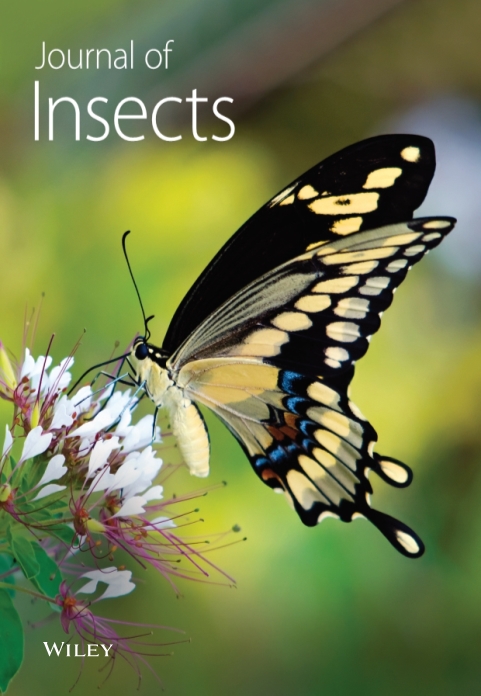利用 DI-SPME-GC/MS 分析缺氧环境下暴露于植物检疫辐照剂量的 Bactrocera dorsalis (Diptera: Tephritidae) 幼虫的发育和代谢组学特征
IF 2.7
2区 农林科学
Q1 ENTOMOLOGY
引用次数: 0
摘要
X 射线辐照和改良气氛(MAs)为害虫管理提供了生态友好、不含化学物质的方法。虽然低氧大气处理可改善某些辐照昆虫的表现,但其对检疫昆虫辐照的影响及其对害虫控制效果的影响还有待研究。根据生物测定结果,本研究采用直接浸入式固相微萃取(DI-SPME)结合气相色谱-质谱联用技术(GC-MS)测定了三龄晚虫的代谢谱。dorsalis 幼虫在常氧(CON,空气)、缺氧(95% N2 + 5% O2,HY)、超缺氧(99.5% N2 + 0.5% O2,Sup-HY)、单独辐照(116 Gy,单独 IR)、缺氧 + 辐照(HY + IR)和超缺氧 + 辐照(Sup-HY + IR)条件下的代谢概况。我们的研究结果表明,与单用 IR 组相比,在 HY 和 Sup-HY 条件下进行 IR 处理(HY + IR 和 Sup-HY + IR)可提高背甲线虫的幼虫化蛹率,并减弱 IR 对幼虫发育阶段的延迟作用。然而,在植物检疫剂量为 116 Gy 的红外条件下,这三个组进一步阻碍了成虫的出现。此外,所有红外处理组,包括单独红外处理组、HY + 红外处理组和 Sup-HY + 红外处理组,都会导致昆虫以尾状幼虫或蛹的形式死亡。通路分析确定了各处理组发生变化的代谢通路。具体来说,观察到脂质代谢相关通路发生了变化:HY与CON相比有3条,Sup-HY与CON相比有2条,IR-alone与CON、HY + IR与CON、Sup-HY + IR与CON相比各有5条。单用 IR、HY + IR 和 Sup-HY + IR 可引起代谢途径的类似改变。然而,在 HY + IR 和 Sup-HY + IR 组中,背甲鱼三龄幼虫的变化明显较少。我们的研究表明,低氧环境(HY 和 Sup-HY)可将脂质代谢途径稳定在生物可行的水平上,从而增强背甲蛙幼虫的辐射耐受性。此外,我们的研究结果表明,目前的植物检疫红外剂量有助于有效管理背甲线虫,而不受辐射防护效应的影响。这些结果对于了解辐射对背甲线虫的生物效应以及在千年生态系统评估环境下制定针对红外的监管指南具有重要意义。本文章由计算机程序翻译,如有差异,请以英文原文为准。
Development and Metabolomic Profiles of Bactrocera dorsalis (Diptera: Tephritidae) Larvae Exposed to Phytosanitary Irradiation Dose in Hypoxic Environment Using DI-SPME-GC/MS
X-ray irradiation and modified atmospheres (MAs) provide eco-friendly, chemical-free methods for pest management. Although a low-oxygen atmospheric treatment improves the performance of some irradiated insects, its influence on the irradiation of quarantine insects and its impacts on pest control efficacy have yet to be investigated. Based on bioassay results, this study employed direct immersion solid-phase microextraction (DI-SPME) combined with gas chromatography-mass spectrometry (GC-MS) to determine metabolic profiles of late third-instar B. dorsalis larvae under normoxia (CON, Air), hypoxia (95% N2 + 5% O2, HY), super-hypoxia (99.5% N2 + 0.5% O2, Sup-HY), irradiation-alone (116 Gy, IR-alone), hypoxia + irradiation (HY + IR) and super-hypoxia + irradiation (Sup-HY + IR). Our findings reveal that, compared to the IR-alone group, the IR treatment under HY and Sup-HY (HY + IR and Sup-HY + IR) increases the larval pupation of B. dorsalis, and weakens the delaying effect of IR on the larval developmental stage. However, these 3 groups further hinder adult emergence under the phytosanitary IR dose of 116 Gy. Moreover, all IR-treated groups, including IR-alone, HY + IR, and Sup-HY + IR, lead to insect death as a coarctate larvae or pupae. Pathway analysis identified changed metabolic pathways across treatment groups. Specifically, changes in lipid metabolism-related pathways were observed: 3 in HY vs. CON, 2 in Sup-HY vs. CON, and 5 each in IR-alone vs. CON, HY + IR vs. CON, and Sup-HY + IR vs. CON. The treatments of IR-alone, HY + IR, and Sup-HY + IR induce comparable modifications in metabolic pathways. However, in the HY + IR, and Sup-HY + IR groups, the third-instar larvae of B. dorsalis demonstrate significantly fewer changes. Our research suggests that a low-oxygen environment (HY and Sup-HY) might enhance the radiation tolerance in B. dorsalis larvae by stabilizing lipid metabolism pathways at biologically feasible levels. Additionally, our findings indicate that the current phytosanitary IR dose contributes to the effective management of B. dorsalis, without being influenced by radioprotective effects. These results hold significant importance for understanding the biological effects of radiation on B. dorsalis and for developing IR-specific regulatory guidelines under MA environments.
求助全文
通过发布文献求助,成功后即可免费获取论文全文。
去求助
来源期刊

Insects
Agricultural and Biological Sciences-Insect Science
CiteScore
5.10
自引率
10.00%
发文量
1013
审稿时长
21.77 days
期刊介绍:
Insects (ISSN 2075-4450) is an international, peer-reviewed open access journal of entomology published by MDPI online quarterly. It publishes reviews, research papers and communications related to the biology, physiology and the behavior of insects and arthropods. Our aim is to encourage scientists to publish their experimental and theoretical results in as much detail as possible. There is no restriction on the length of the papers. The full experimental details must be provided so that the results can be reproduced. Electronic files regarding the full details of the experimental procedure, if unable to be published in a normal way, can be deposited as supplementary material.
 求助内容:
求助内容: 应助结果提醒方式:
应助结果提醒方式:


